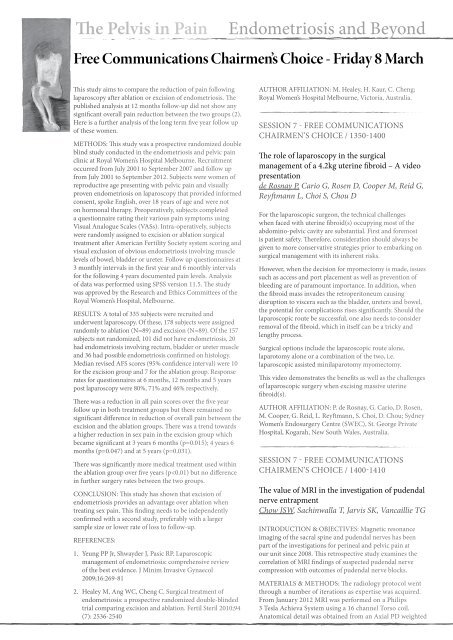AGES XXIII Annual Scientific Meeting 2013 Abstracts & Program
AGES XXIII Annual Scientific Meeting 2013 Abstracts & Program
AGES XXIII Annual Scientific Meeting 2013 Abstracts & Program
You also want an ePaper? Increase the reach of your titles
YUMPU automatically turns print PDFs into web optimized ePapers that Google loves.
The Pelvis in Pain<br />
Endometriosis and Beyond<br />
Free Communications Chairmen’s Choice - Friday 8 March<br />
This study aims to compare the reduction of pain following<br />
laparoscopy after ablation or excision of endometriosis. The<br />
published analysis at 12 months follow-up did not show any<br />
significant overall pain reduction between the two groups (2).<br />
Here is a further analysis of the long term five year follow up<br />
of these women.<br />
METHODS: This study was a prospective randomized double<br />
blind study conducted in the endometriosis and pelvic pain<br />
clinic at Royal Women’s Hospital Melbourne. Recruitment<br />
occurred from July 2001 to September 2007 and follow up<br />
from July 2001 to September 2012. Subjects were women of<br />
reproductive age presenting with pelvic pain and visually<br />
proven endometriosis on laparoscopy that provided informed<br />
consent, spoke English, over 18 years of age and were not<br />
on hormonal therapy. Preoperatively, subjects completed<br />
a questionnaire rating their various pain symptoms using<br />
Visual Analogue Scales (VASs). Intra-operatively, subjects<br />
were randomly assigned to excision or ablation surgical<br />
treatment after American Fertility Society system scoring and<br />
visual exclusion of obvious endometriosis involving muscle<br />
levels of bowel, bladder or ureter. Follow up questionnaires at<br />
3 monthly intervals in the first year and 6 monthly intervals<br />
for the following 4 years documented pain levels. Analysis<br />
of data was performed using SPSS version 11.5. The study<br />
was approved by the Research and Ethics Committees of the<br />
Royal Women’s Hospital, Melbourne.<br />
RESULTS: A total of 335 subjects were recruited and<br />
underwent laparoscopy. Of these, 178 subjects were assigned<br />
randomly to ablation (N=89) and excision (N=89). Of the 157<br />
subjects not randomized, 101 did not have endometriosis, 20<br />
had endometriosis involving rectum, bladder or ureter muscle<br />
and 36 had possible endometriosis confirmed on histology.<br />
Median revised AFS scores (95% confidence interval) were 10<br />
for the excision group and 7 for the ablation group. Response<br />
rates for questionnaires at 6 months, 12 months and 5 years<br />
post laparoscopy were 80%, 71% and 46% respectively.<br />
There was a reduction in all pain scores over the five year<br />
follow up in both treatment groups but there remained no<br />
significant difference in reduction of overall pain between the<br />
excision and the ablation groups. There was a trend towards<br />
a higher reduction in sex pain in the excision group which<br />
became significant at 3 years 6 months (p=0.015); 4 years 6<br />
months (p=0.047) and at 5 years (p=0.031).<br />
There was significantly more medical treatment used within<br />
the ablation group over five years (p
















